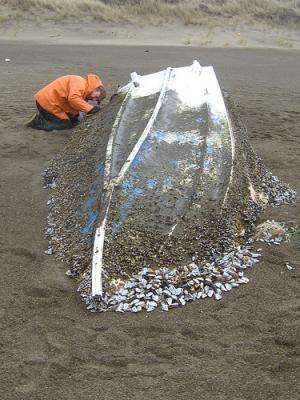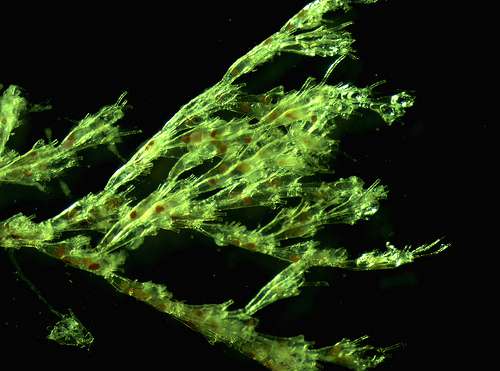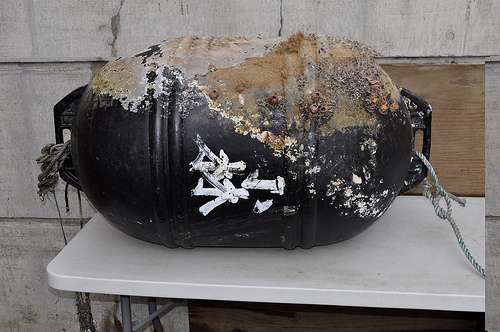Invasive species danger from tsunami may not be known for years

(Phys.org) —Scientists from Oregon State University, who have examined more than three dozen pieces of debris from the 2011 Japanese tsunami that have washed ashore on the Northwest coast, say the potential damage from invasive species may not be known for years.
The researchers say some of the pieces of debris they've examined have included algae, barnacles, mussels, starfish, snails and other organisms that are found only in Asia. While few species on the floating debris are native exclusively to the West Coast of the United States, several of the species they examined can be found in both locations.
Which of the species originating in Asia, if any, gains a toehold in the Pacific Northwest – and what potential damage there may be ecologically and economically – is nearly impossible to anticipate, they say.
"Ecologists have a terrible track record of predicting what introduced species will survive and where," acknowledged John Chapman, a marine invasive species specialist at OSU's Hatfield Marine Science Center in Newport, Ore. "The real question for scientists who study these species is the big picture view – how do things get introduced into a new location and move around the world?
"The Japanese tsunami was a terrible tragedy and the debris that is arriving is certainly an unintended consequence," he added. "But it is providing us with an unprecedented experiment on species introduction."
Chapman and OSU colleague Jessica Miller were among the first scientists to examine the huge dock that washed ashore in June of 2012 near Newport. Ripped from its moorings in Misawa, Japan, it floated across the Pacific Ocean for 15 months, arriving near Agate Beach covered in seaweed, barnacles, mussels and other organisms.
Since then, they have examined another Misawa dock that beached in northwest Washington, as well as numerous boats and other large pieces of debris. Models produced by the National Oceanic and Atmospheric Administration suggest that another peak of debris will arrive on the West Coast between now and June, as favorable winds and currents drive floating objects ashore.

It should subside during the late spring and summer, Miller noted, but some debris is projected to arrive over the next five years.
"We're observing more 'settlement' on these debris items that appears to have occurred soon after the tsunami," said Miller, an OSU marine ecologist at the Hatfield Marine Science Center. "Recently, we have sampled several boats that were clearly colonized by animals, such as the blue mussel, after the tsunami.
"We are trying to improve our understanding of the mechanisms that allow organisms to disperse across the ocean," she added.
The researchers say that some of the Asian aquatic species that "hitchhiked" aboard the tsunami debris may have reproduced during their trans-Pacific journey, and it is possible they could have released gametes into local coastal waters. This increases the chance that these non-native organisms may become established and turn into invasive species.
Once established, these species also have the potential to breed with similar local species and create hybrid organisms, the researchers noted. "Certainly there is precedent for that in the invasive species world," Chapman pointed out. "Just look at kudzu, Himalayan blackberry and English ivy – they're all hybrids. So the potential exists."

The OSU scientists and three other researchers have received a grant from the National Science Foundation to quantify the species arriving on tsunami debris, assess their abundance, and characterize the organisms morphologically and genetically. They also are examining the species' reproductive state and looking for parasites on host organisms.
Other researchers involved in the project include Jim Carlton of Williams College, who is one of the leading experts in the world on marine invasive species; Gregory Ruiz of the Smithsonian Environmental Research Center and Portland State University (who studies parasites and pathogens); and Jon Geller of Moss Landing Marine Laboratories (who studies genetics).
As the two-year anniversary of the Tohoku earthquake and tsunami approaches, the OSU scientists say the risk of non-native species aboard the debris becoming invasive is still very real.
"From day one, we've been asked which species we should be worried about," Chapman said, "and the answer is just not that simple. We cannot predict which starfish or algae species poses the biggest threat – but we know that invasions in general are bad. We just don't know which of them, if any, will turn out to be a problem five, 10 or 20 years down the road.
"And we do know that the rate of new, introduced species discoveries has increased exponentially over the last hundred years," Chapman added. "More are coming."
Miller concurs, saying the threat from the tsunami debris may not be known for years.
"I think it is safe to say that we are still concerned that some of these non-native species could establish themselves along our West Coast," she said. "And the potential ecological impacts could be significant."
Provided by Oregon State University

















